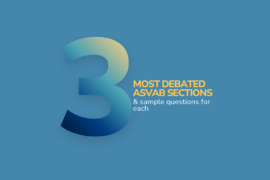The Preliminary Standardized Assessment Test (PSAT), also known as the National Merit Scholarship Qualifying Test (NMSQT), are meant to test your knowledge and prepare you for taking the SAT before entering college. Students typically take the PSAT as a sophomore or junior, and then go on to take the SAT as a junior or senior before graduating high school.
The questions on the test will help give you an idea of content areas you need to work on before taking the SAT, and it will also qualify you for scholarships if you score well. If you get a chance to take the PSAT, some high schools will even pay for your test fees, you should absolutely do so, just make sure to study in advance so that you get the most out of taking the PSAT.
What’s on the test?
The PSAT is comprised of three different sections: reading, writing, and math. There are 139 questions total and you will have 2 hours and 45 minutes to complete the test, minutes for the reading section, 70 minutes for math, and 35 minutes for writing. Most questions are multiple choice, there is no essay like there is in the SAT, and you will be able to use a calculator.
Learn more about studying for the PSAT
Reading
The reading section of the PSAT consists of 47 questions and you are given 60 minutes to complete it. All of the questions are multiple choice and based off of long and short paragraphs. You will be asked to read a paragraph and answer a series of questions about specific details in the passage and what the author implies. These questions are designed to assess your ability of the author to make claims based on evidence and best conclude the author’s intentions.
There is also informational graphics you will be given, for example, tables, graphs, or charts, and then asked to answer a question about the data that is given. No math is involved here, but you will have to know how to interpret data from a graphic.
The reading section will encompass a number of different topic areas, including U.S. history, psychology, economics, social science, and science. The questions won’t require you to have background knowledge in the subject, though you will have to use your reading skills to determine what the passage is arguing and how an author shapes their argument through evidence, style, and tone.
Writing and Language
The writing and language section consists of 44 multiple choice questions and you are given 35 minutes to complete. You will be tested on grammar, vocabulary in context, and editing skills. In other words, you will have to read a sentence or passage, identify mistakes in grammar, find weaknesses in an argument, and fix them.
Some questions in this section will also have an informational graphic to accompany the passage, and you will be asked to correct a misinterpretation of the graphic or choose an answer that better explains the data in question. Subjects will range from nonfiction, careers, history, social studies, science, and literature.
When taking this test, focus on contextual clues to help define difficult language and how one might express those ideas in a more impactful way. You will need to have a command of the English language in terms of sentence structure, including verb-tense, subject-verb agreement, and correct use of punctuation.
Math
The math section is 48 multiple choice and grid-in questions. You will have 70 minutes to complete it. There are two different portions of this section, one where you can use a calculator and one where you cannot. It will test your skills in algebra, geometry, data analysis, and overall conceptual understanding of mathematical concepts.
You won’t be tested just on your ability to solve equations, though that is a part of it. You will also have to make connections between linear equations and their graphs, determine the most efficient way to solve a mathematical problem, and demonstrate quantitative literacy.
For the grid-in questions, you’ll be asked to provide the answer rather than it being multiple choice. You’ll have to solve an equation and enter in your exact answer. Mix numbers will need to be converted to improper fractions, you’ll have to round repeating decimals to the most accurate value that the grid allows, though you won’t have to simplify fractions to their lowest terms if it fits in the grid. You’ll want to spend extra time making sure you get these questions right without making any mistakes.
Take multiple practice tests
The best way to prepare for the PSAT is by taking multiple practice tests. Practice tests can be found online for free through multiple websites, and you can also buy study guides that include practice tests for each section and questions to study. Take multiple practice tests and assess your strengths and weakness after each one.
The night before you take the test
Don’t cram the night before you take the test. Get your studying out of the way a couple of days in advance of taking the test, so that the night before you take the test you can relax and get some rest. Your brain needs to refresh and be prepared for the test. If you have to, skim over certain strategies, but don’t spend too much time studying the night before. If you don’t know an answer, guess! You don’t lose points for wrong answers, but you do lose points for skipped answers. Random guessing won’t do much for your score, but if you can make an educated guess (where you eliminate at least one of your answer choices), you can boost your chances of getting the question right. This helps when you feel stuck on the right answer but want to move on and can rule out at least one of the other answer choices.


